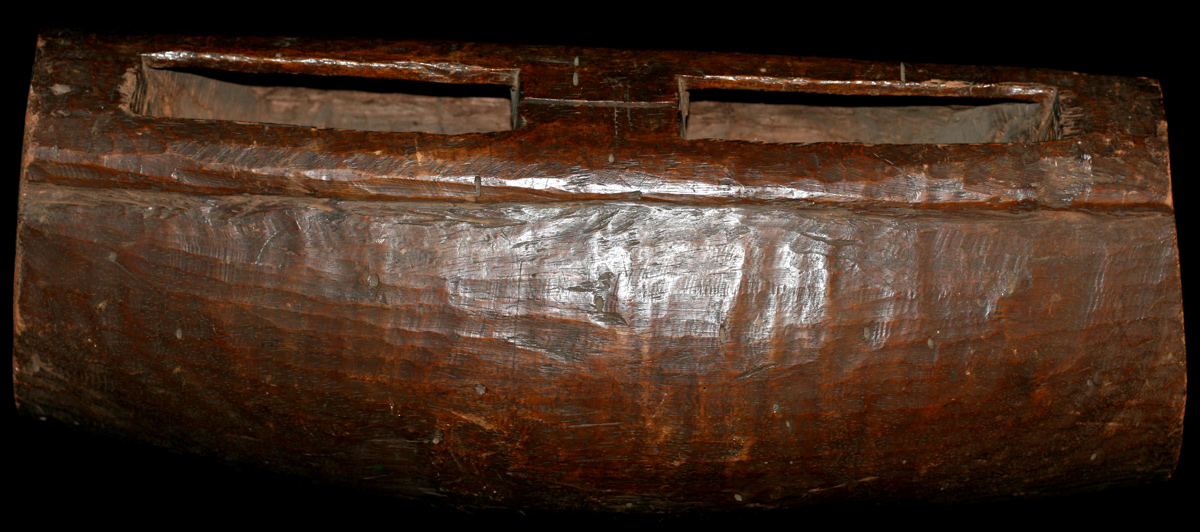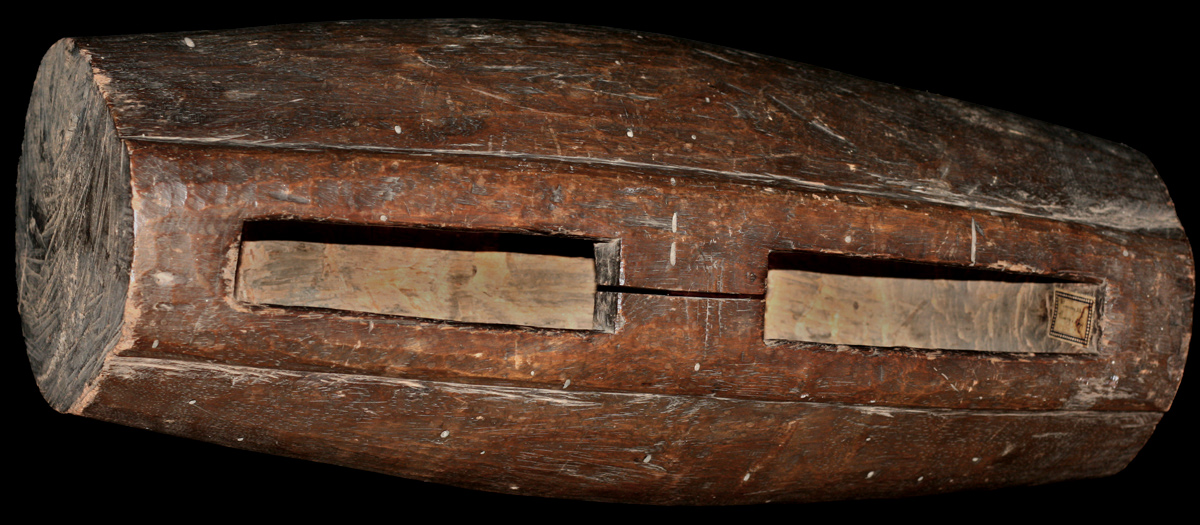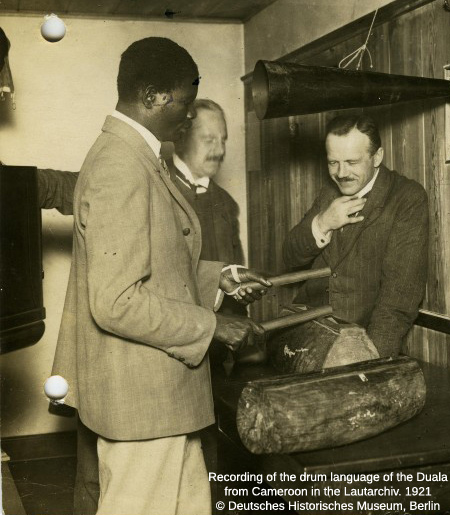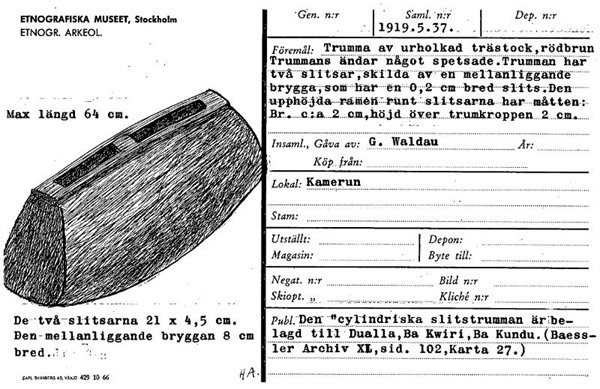DRUMS OF THE WORLD
Africa
duala slit drum cameroon
Duala slit drum / tambour à fente / Schlitztrommel Cameroon
"A good example of the caution that must be employed is the drum-signalling of the Duala of the Southern Cameroons, perhaps the most frequently studied of all instrumental systems. Betz (1898:3), who made the first systematic study, noted that while many words or sentences correspond with their spoken counterparts in tone height, stress, and tempo, they are outnumbered by those for which this correspondence does not hold true; this led Sembritski (Nekes 1917: 73) to term it in essence an encoding system. Meinhof (in Thilenius et al 1916:183), on the basis of his own experience with the Duala, also denied a direct correspondence between the physical features of the signal and those of the spoken word. Nekes, on the other hand (1912:73) was in essential agreement with Betz, but pointed out that his residual class included rare expressions which had disappeared from colloquial use. He added (1912:73f.) that most drum signals are formal paraphrases, often poetic, of brief oral utterances. Moreover, "it can happen that the younger generation may lose sight of the immediate significance of the long signal and think of it as an arbitrary sign inherited from their fathers." "
excerpt from: Stern, Theodore : Drum and Whistle "Languages": An Analysis of Speech Surrogates.
"The three most common slit drum types are the cylindrical, the trapezoid and the zoomorphic. Besides these we also find them in the form of a tulip, half-moon and boat. The basic structure of the drum is virtually the same for each type and is best illustrated by the cylindrical slit drum. A block of wood, usually part of a tree trunk, is cut into the desired shape and then hollowed out through the slit in the upper side. The drum-maker/woodcutter ensures that the two sides of the drum are unequal in thickness so that different pitches are produced when played with two rubber-headed drum sticks. The two-tone structure will later form the basis for the transmission of a message, the purpose for which these instruments are best known. The creativity of the drum-maker and woodcutter is clearly visible in the way the upper side around the slit is decorated. This can be done by making the simple cut for the slit and by adding two "sound holes" at each end, or by decorating the area around the slit with geometric patterns."
Copyright © Royal Museum for Central Africa ('RMCA'), 2018. All rights reserved.
excerpt from the website:http://music.africamuseum.be/instruments/english/congo%20drc/bakpekpe.html
Die Schlitztrommel ist das wichtigste Signalinstrument in Zentralafrika und kann zur Nachrichtenübermittlung (Sprechtrommeln) verwendet werden.
Die beiden Wandungen der Trommel sind unterschiedlich dick und erzeugen beim Anschlagen zwei unterschiedliche Töne. Sprachmelodie und Sprachrhythmus können so von Spezialisten auf das Instrument übertragen werden.
Bibliography:
Stern, Theodore : Drum and Whistle "Languages": An Analysis of Speech Surrogates.
Armstrong, Robert G. - Talking instruments in West Africa. Explorations 4: 140-153.
Betz, R. 1898 : Die Trommelsprache der Duala. Mitteilungen von Forschungsreisenden und Gelehrten aus den deutschen Schutzgebieten 11: 1-86.
Carrington, John F. (1949) : Talking drums of Africa. Carey Kingsgate Press.
Carrington, John F. (1944). The drum language of the Lokele tribe.
Herzog, George (1934) Speech-melody and primitive music. Musical Quarterly 20:452-466.
Herzog, George (1944) Drum-signalling in a West African tribe. Word 1:217-238.
Kubik, Gerhard ; Malamusi Moya Aliya ; Varsányi,András : Afrikanische Musikinstrumente. Katalog und Nachdokumentation der Musikinstrumente aus Afrika südlich der Sahara in der Sammlung Musik des Münchner Stadtmuseums.
Laurenty, Jean-Sébastien : Les tambours à fente de l'Afrique centrale, Musée royal de l'Afrique centrale, Tervuren, 1968, 2 vol.
Nekes, Hermann (1912) Trommelsprache und Fernruf bei den Jaunde und Duala in Südkamerun. Mitteilungen des Seminar fur orientalische Sprachen, vol. 15, Section 3:69-83.
Thilenius, B., C. Meinhof, and W. Heinitz (1916) Die Trommelsprache in Afrika und in der Sudsee. Vox 26:179-208.
"A good example of the caution that must be employed is the drum-signalling of the Duala of the Southern Cameroons, perhaps the most frequently studied of all instrumental systems. Betz (1898:3), who made the first systematic study, noted that while many words or sentences correspond with their spoken counterparts in tone height, stress, and tempo, they are outnumbered by those for which this correspondence does not hold true; this led Sembritski (Nekes 1917: 73) to term it in essence an encoding system. Meinhof (in Thilenius et al 1916:183), on the basis of his own experience with the Duala, also denied a direct correspondence between the physical features of the signal and those of the spoken word. Nekes, on the other hand (1912:73) was in essential agreement with Betz, but pointed out that his residual class included rare expressions which had disappeared from colloquial use. He added (1912:73f.) that most drum signals are formal paraphrases, often poetic, of brief oral utterances. Moreover, "it can happen that the younger generation may lose sight of the immediate significance of the long signal and think of it as an arbitrary sign inherited from their fathers." "
excerpt from: Stern, Theodore : Drum and Whistle "Languages": An Analysis of Speech Surrogates.
"The three most common slit drum types are the cylindrical, the trapezoid and the zoomorphic. Besides these we also find them in the form of a tulip, half-moon and boat. The basic structure of the drum is virtually the same for each type and is best illustrated by the cylindrical slit drum. A block of wood, usually part of a tree trunk, is cut into the desired shape and then hollowed out through the slit in the upper side. The drum-maker/woodcutter ensures that the two sides of the drum are unequal in thickness so that different pitches are produced when played with two rubber-headed drum sticks. The two-tone structure will later form the basis for the transmission of a message, the purpose for which these instruments are best known. The creativity of the drum-maker and woodcutter is clearly visible in the way the upper side around the slit is decorated. This can be done by making the simple cut for the slit and by adding two "sound holes" at each end, or by decorating the area around the slit with geometric patterns."
Copyright © Royal Museum for Central Africa ('RMCA'), 2018. All rights reserved.
excerpt from the website:http://music.africamuseum.be/instruments/english/congo%20drc/bakpekpe.html
Die Schlitztrommel ist das wichtigste Signalinstrument in Zentralafrika und kann zur Nachrichtenübermittlung (Sprechtrommeln) verwendet werden.
Die beiden Wandungen der Trommel sind unterschiedlich dick und erzeugen beim Anschlagen zwei unterschiedliche Töne. Sprachmelodie und Sprachrhythmus können so von Spezialisten auf das Instrument übertragen werden.
Bibliography:
Stern, Theodore : Drum and Whistle "Languages": An Analysis of Speech Surrogates.
Armstrong, Robert G. - Talking instruments in West Africa. Explorations 4: 140-153.
Betz, R. 1898 : Die Trommelsprache der Duala. Mitteilungen von Forschungsreisenden und Gelehrten aus den deutschen Schutzgebieten 11: 1-86.
Carrington, John F. (1949) : Talking drums of Africa. Carey Kingsgate Press.
Carrington, John F. (1944). The drum language of the Lokele tribe.
Herzog, George (1934) Speech-melody and primitive music. Musical Quarterly 20:452-466.
Herzog, George (1944) Drum-signalling in a West African tribe. Word 1:217-238.
Kubik, Gerhard ; Malamusi Moya Aliya ; Varsányi,András : Afrikanische Musikinstrumente. Katalog und Nachdokumentation der Musikinstrumente aus Afrika südlich der Sahara in der Sammlung Musik des Münchner Stadtmuseums.
Laurenty, Jean-Sébastien : Les tambours à fente de l'Afrique centrale, Musée royal de l'Afrique centrale, Tervuren, 1968, 2 vol.
Nekes, Hermann (1912) Trommelsprache und Fernruf bei den Jaunde und Duala in Südkamerun. Mitteilungen des Seminar fur orientalische Sprachen, vol. 15, Section 3:69-83.
Thilenius, B., C. Meinhof, and W. Heinitz (1916) Die Trommelsprache in Afrika und in der Sudsee. Vox 26:179-208.



